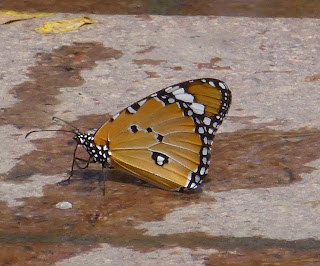Ernesettle Creek is a site I have never visited before despite it being in Plymouth. It is good for spotted redshanks and spoonbills in the winter due to the occassional visits from the wintering birds on the Tamar/Tavy/Lynher complex. The footpath runs right alongside the Creek but is shielded by trees and shrubs making viewing difficult although in the winter with the leaves gone it would be much easier to view.
I did see lots of redshanks along the Creek and at least 4 greenshanks along with teal, mallard, little egrets and black-headed and herring gulls. A snipe flew downriver calling and a feeding flock of very active and mobile blue, great, coal and long-tailed tits contained at least 1 goldcrest and a probable chiffchaff. A tawny owl and a great spotted woodpecker were also heard and jays were seen and heard. Speckled woods flitted about in the mild and humid weather.
It has been mild and humid overnight too and so I have had the moth box out in the back yard. Numbers have been unsurprisingly low but I did have a very nice willow beauty along with white shouldered house moth, common marbled carpet, large yellow underwing and plume moth.
White Shouldered House Moth
A day off again on Thursday (25th) so I headed off to Wembury on the bus. As I left the house 12 Canada geese flew over and at Wembury I had a count of 46 Canada geese feeding in the stubble field, my highest count at Wembury.
Some of the 46 Canada Geese feeding in the stubble field with Rooks, Jackdaws and Herring Gulls
The horsefields were full of mobile meadow pipits and pied wagtails along with a rock pipit and 2 juvenile wheatears and a small flock of goldfinch. A second winter Mediterranean gull hawked back and forth across the stubble field, swooping down to grab worms, and on the rocks 3 adult lesser black backed gulls were roosting amongst the herring, black headed and great black backed gulls. Offshore 2 adult gannets flew East and amongst the mallards feeding along the beach was a male farmyard type which I haven't seen here before.
Juvenile Wheatear
Goldfinch
Best birds were 5 Brent geese found on the walk back, they were resting on the sea near the sewage pipe and are my second Wembury sighting. They didn't hang around for long due to disturbance from dog walkers and they eventually flew off East.
4 of the 5 Brent Geese
The toilet block had been vandalised again, have people really got nothing better to do, but it did contain 2 snout (1 faded, 1 smart), a Eudonia augustea (ID'd by Douglas from the Back Garden Moth Community forum!) and a small drinker moth caterpillar. I have seen drinker moth caterpillars in the spring when they are so much larger than the one I saw today and it threw me at first as to what it was.
Snout
Eudonia angustea
Drinker Moth Caterpillar
I decided to skip having a pasty and headed back to Plymouth on the bus before heading out to Ernesettle Creek by bus to have another hunt for the lesser yellowlegs. It had only been reported on the sightings pages on Tuesday (not Monday or Wednesday) so I wasn't overly hopeful but within 20 minutes of searching I found it feeding with a group of redshanks and 7 greenshanks on the mudflats as the tide came in before it flew off downriver. I had some excellent views, much better than the views I had of the bird at Kingsmill Lake in March this year, and I was very pleased to have my telescope to view it with. It was much smaller and slimmer built than the redshanks it was feeding with and with white underparts and obviously very yellow legs! When it flew off it lacked white markings in its upperwings and its yellow feet protruded out beyond its white rumped tail and again it was noticeably smaller and slimmer built than the redshanks. I managed to get a few crap photos as record shots, unfortunately they don't show the yellow legs.
Lesser Yellowlegs
Lesser Yellowlegs
Lesser Yellowlegs
And so it had been a very good couple of hours birding with a very nice view of the first lesser yellowlegs for Plymouth since 1954!





























































